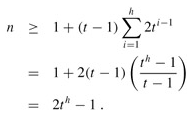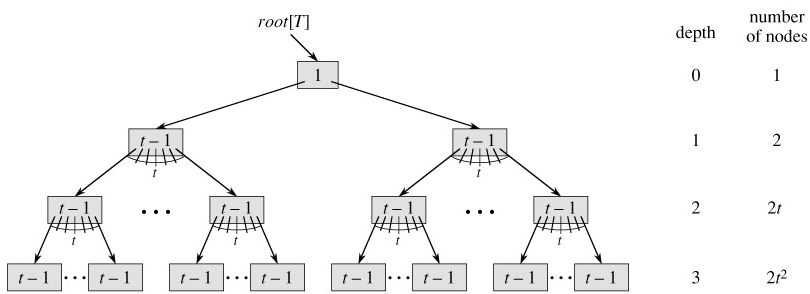SKEDSOFT
Definition of B-trees: To keep things simple, we assume, as we have for binary search trees and red-black trees, that any "satellite information" associated with a key is stored in the same node as the key. In practice, one might actually store with each key just a pointer to another disk page containing the satellite information for that key. The pseudocode in this chapter implicitly assumes that the satellite information associated with a key, or the pointer to such satellite information, travels with the key whenever the key is moved from node to node. A common variant on a B-tree, known as a B - tree, stores all the satellite information in the leaves and stores only keys and child pointers in the internal nodes, thus maximizing the branching factor of the internal nodes.
A B-tree T is a rooted tree (whose root is root[T]) having the following properties:
-
Every node x has the following fields:
-
n[x], the number of keys currently stored in node x,
-
the n[x] keys themselves, stored in nondecreasing order, so that key1[x] ≤ key2[x] ≤ ··· ≤ keyn[x][x],
-
leaf [x], a boolean value that is TRUE if x is a leaf and FALSE if x is an internal node.
-
-
Each internal node x also contains n[x] 1 pointers c1[x], c2[x], ..., cn[x] 1[x] to its children. Leaf nodes have no children, so their ci fields are undefined.
-
The keys keyi[x] separate the ranges of keys stored in each subtree: if ki is any key stored in the subtree with root ci [x], then
k1 ≤ key1[x] ≤ k2 ≤ key2[x] ≤··· ≤ keyn[x][x] ≤ kn[x] 1.
-
All leaves have the same depth, which is the tree's height h.
-
There are lower and upper bounds on the number of keys a node can contain. These bounds can be expressed in terms of a fixed integer t ≥ 2 called the minimum degree of the B-tree:
-
Every node other than the root must have at least t - 1 keys. Every internal node other than the root thus has at least t children. If the tree is nonempty, the root must have at least one key.
-
Every node can contain at most 2t - 1 keys. Therefore, an internal node can have at most 2t children. We say that a node is full if it contains exactly 2t - 1 keys.[1]
-
The simplest B-tree occurs when t = 2. Every internal node then has either 2, 3, or 4 children, and we have a 2-3-4 tree. In practice, however, much larger values of t are typically used.
The height of a B-tree
The number of disk accesses required for most operations on a B-tree is proportional to the height of the B-tree. We now analyze the worst-case height of a B-tree.
If n ≥ 1, then for any n-key B-tree T of height h and minimum degree t ≥ 2,

Proof If a B-tree has height h, the root contains at least one key and all other nodes contain at least t - 1 keys. Thus, there are at least 2 nodes at depth 1, at least 2t nodes at depth 2, at least 2t2 nodes at depth 3, and so on, until at depth h there are at least 2th-1 nodes. Figure 18.4 illustrates such a tree for h = 3. Thus, the number n of keys satisfies the inequality


Figure 18.4: A B-tree of height 3 containing a minimum possible number of keys. Shown inside each node x is n[x].